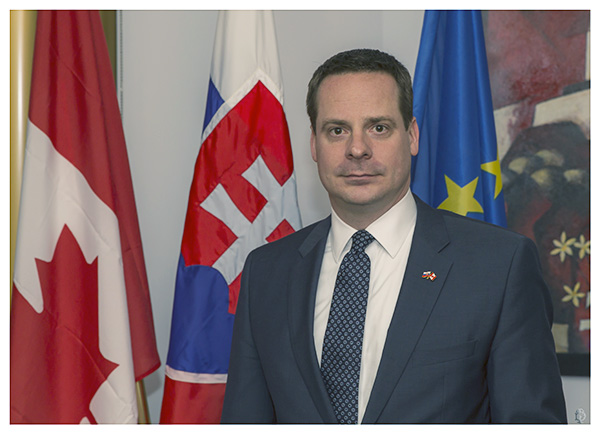
On Monday, Feb 29, the Slovak Republic’s Ambassador to Canada, Andrej Droba, visited the University of Guelph-Humber. While on campus, Ambassador Droja delivered a lecture to 4th-year Business class European Regional Business Studies, and spoke about his work as a diplomat and Slovakian history.
What work is involved with being an ambassador?
The mission of an ambassador is to promote and deepen the relations, cooperation and overall ties between their home country and the country in which they serve. Slovakia and Canada are great partners, friends and allies. My goal is to enhance our relations even further in all areas, including political dialogue, business, trade and investment, security cooperation, academic cooperation, science and research, people to people contacts, culture and tourism. Another part of being an ambassador is to be actively engaged with the Slovak community here in Canada. There are around 100,000 people of Slovak ancestry living in Canada, and about 40,000 of them live in the Greater Toronto Area.
What will you be discussing in your lecture?
I want to introduce the students to Slovakia, a country that a quarter century ago was a member of the Communist Bloc, and tell them a little bit about the successful route the country has travelled since the Velvet Revolution of 1989. It’s a remarkable story and we’ve accomplished a lot. We have joined the European Union, NATO, reformed our economy, adopted the Euro as our currency, attracted foreign investors and made Slovakia one of the fastest-growing economies in Europe.
What’s been the secret of Slovakia’s economic success?
It’s a long story, but the short answer is a combination of political will, unity in our ambitions and goals, hard economic reforms and the support that we have received from our partners. The important element in our economic success was that we have managed to attract foreign investors. We’re very open to investment and we pride ourselves on a highly skilled, highly educated and reliable workforce.
In fact, Slovakia is home to a number of Canadian companies, like Magna and Martinrea, both of which are part of the automotive industry, Slovakia’s biggest industry. It’s something that really drives the economy. Last year, we produced more than 1 million vehicles, which is remarkable for a country of 5.5 million people, and makes us the largest car producer per capita in the world. We create cars for Volkswagen, Porsche, Audi, Kia, Citroen, Peugeot, and we just won a huge bid for Jaguar’s Land Rover. Altogether last year, trade between Canada and Slovakia was about €250 million.
Are there opportunities for Canadian students to travel to and study in Slovakia?
In 2012, our two countries signed the Youth Mobility Agreement, which allows people between 18-35 to go from Canada to Slovakia and vice versa for one year to travel, work or study. They can do whatever they wish with that time without any bureaucratic conditions or requirements. When I travel across Canada I actively promote this program because we’d like to see more Canadians come to Slovakia. We’re a country with great universities, many of which offer classes in English, and I think that for young people, this is a great and easy way to get to know our country. We’re in the heart of Europe and it’s a great place if you want to travel or pursue academic opportunities.
This interview has been edited and condensed for clarity.

